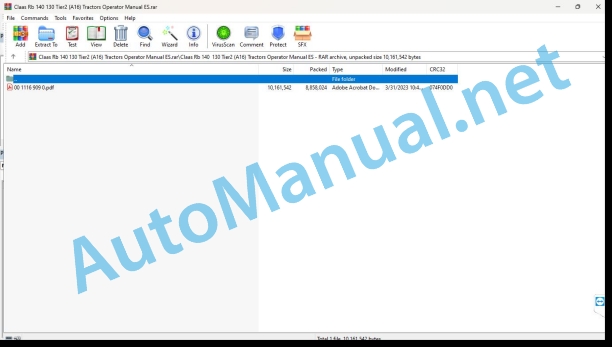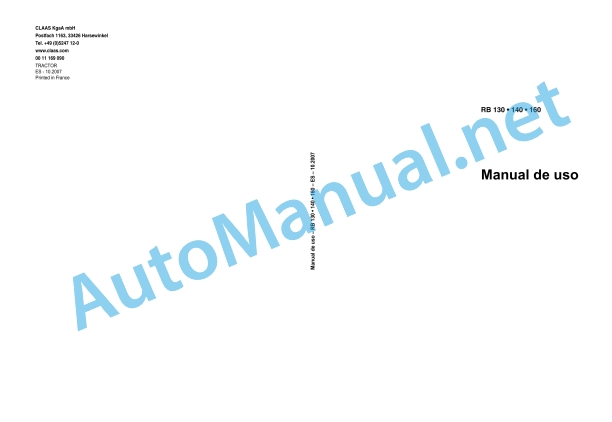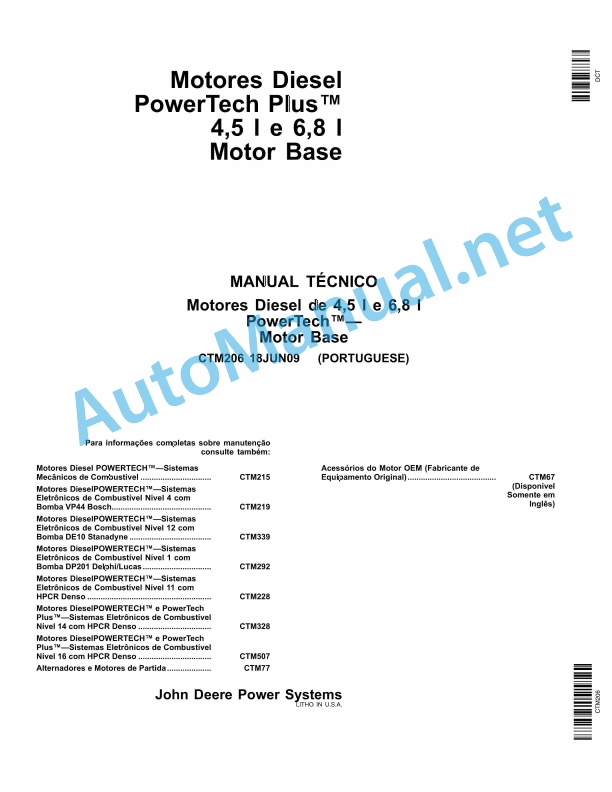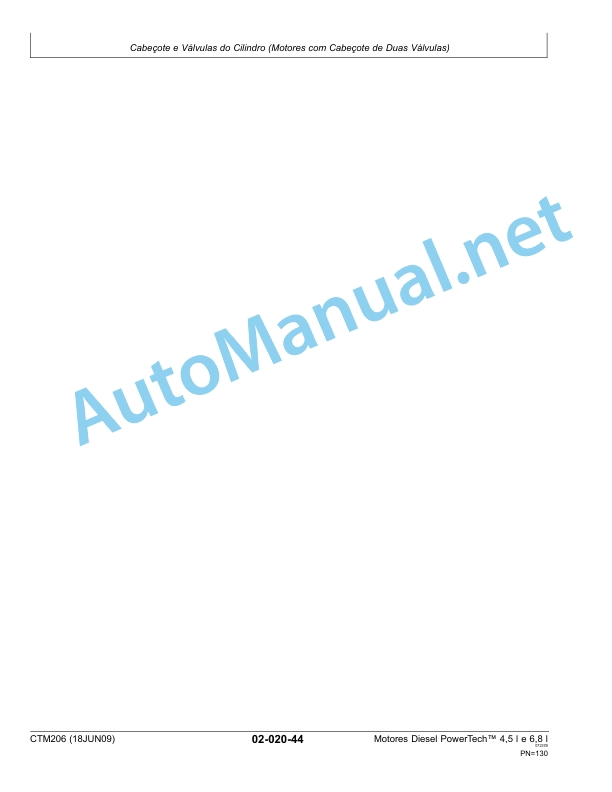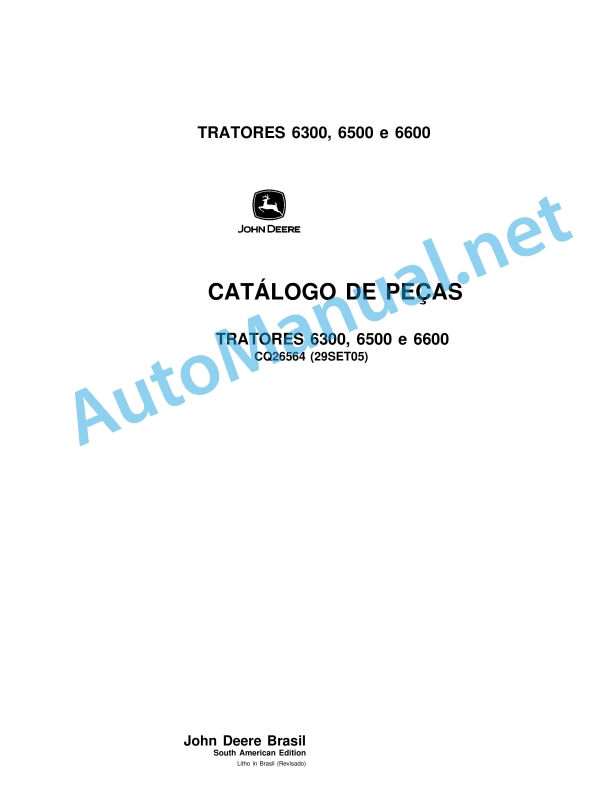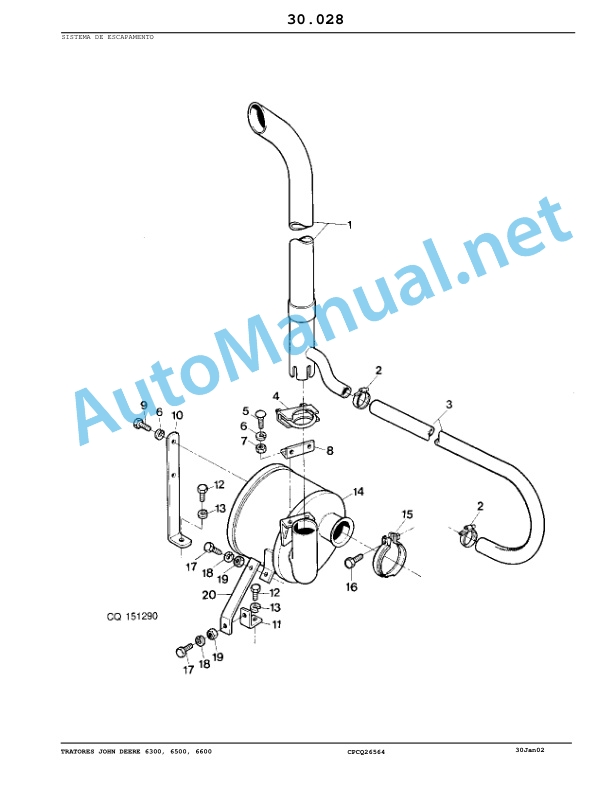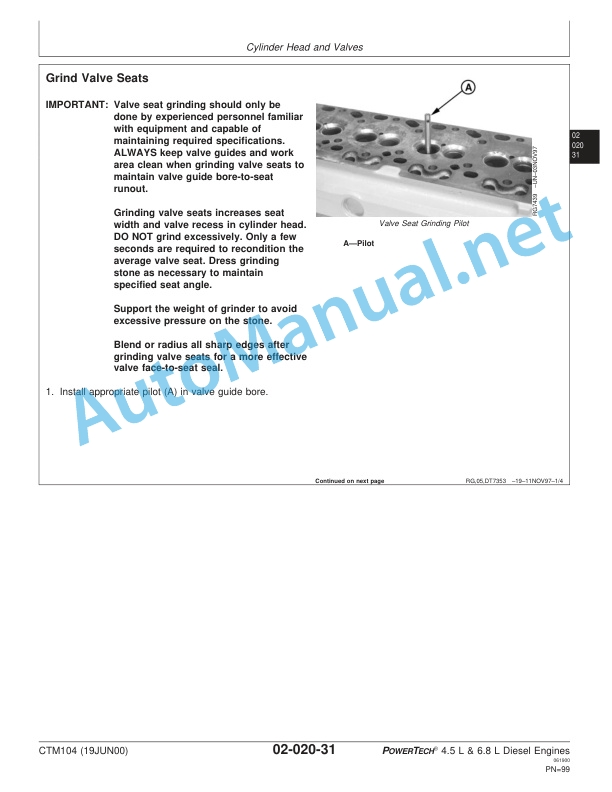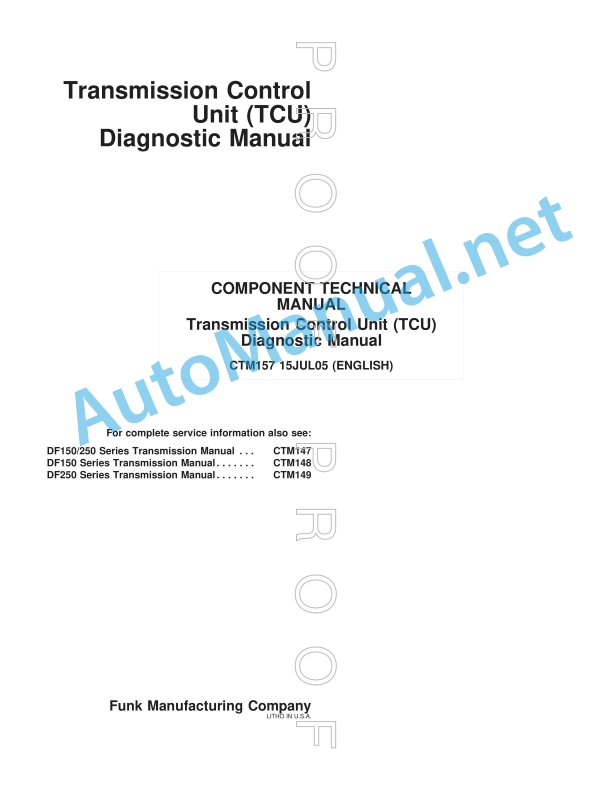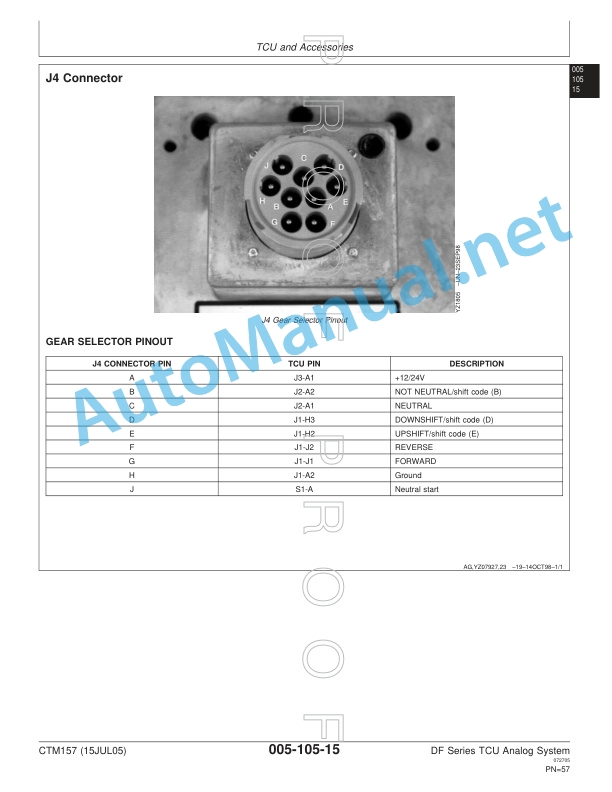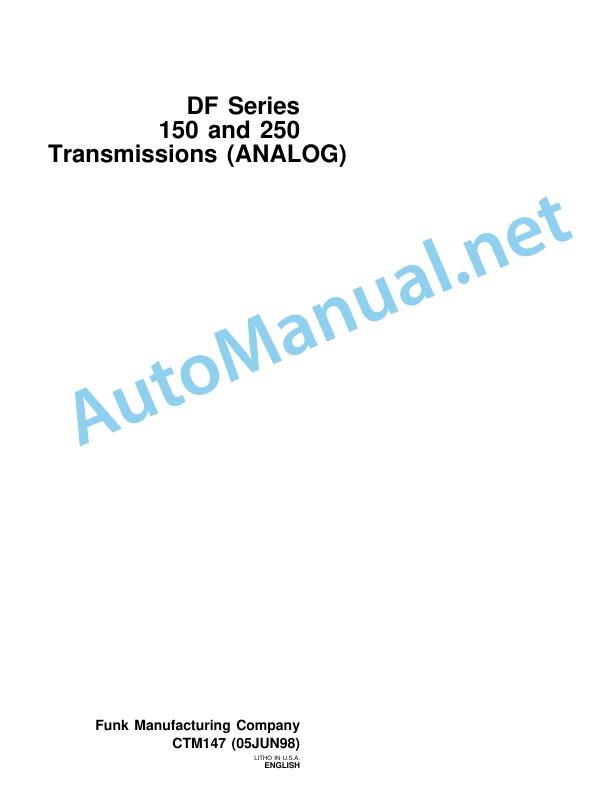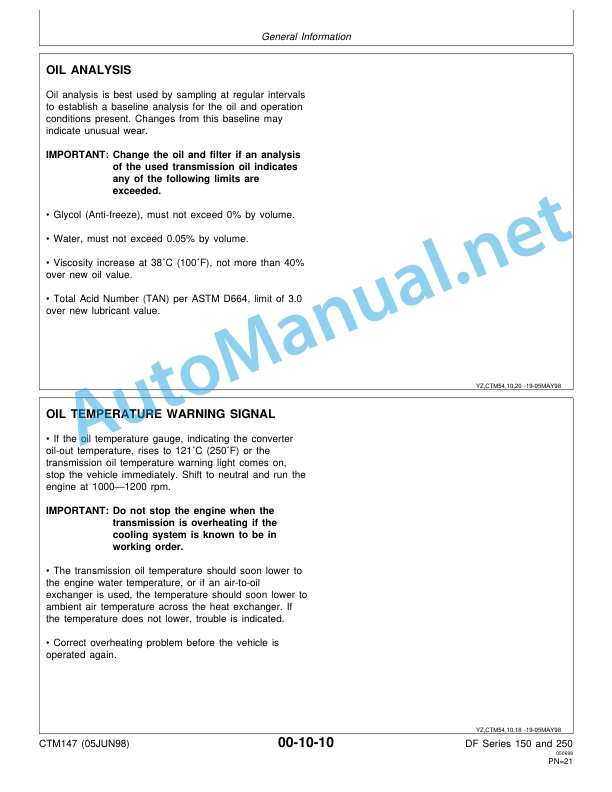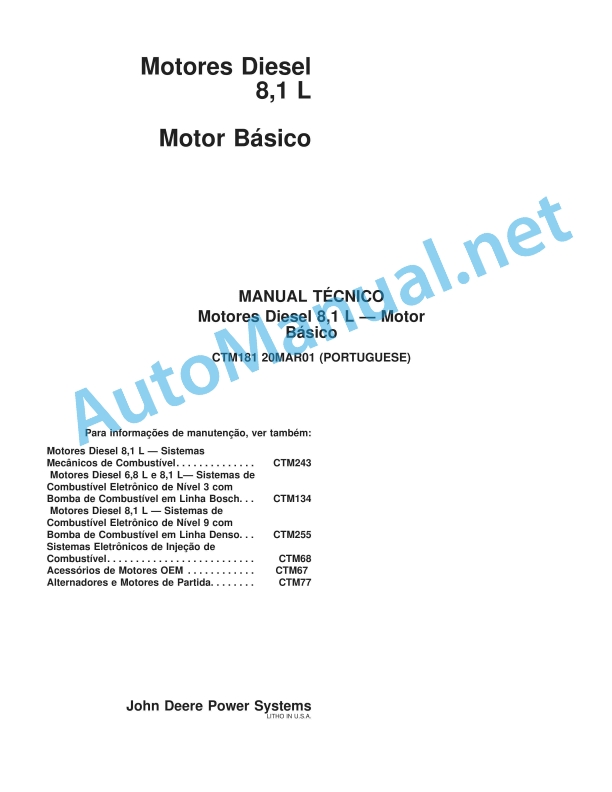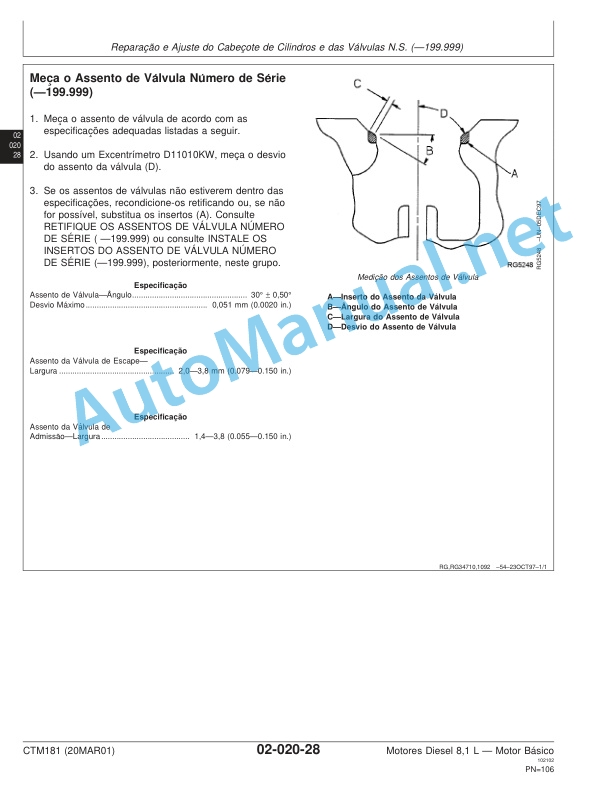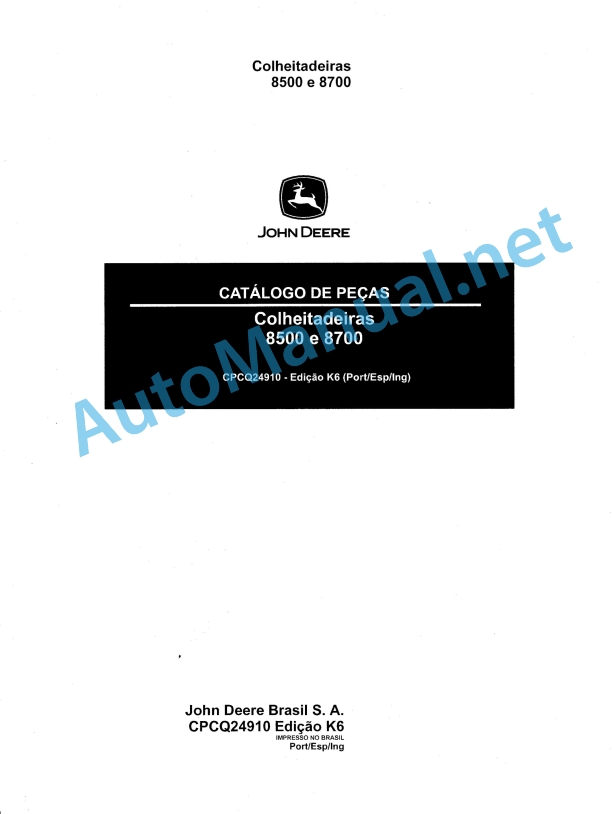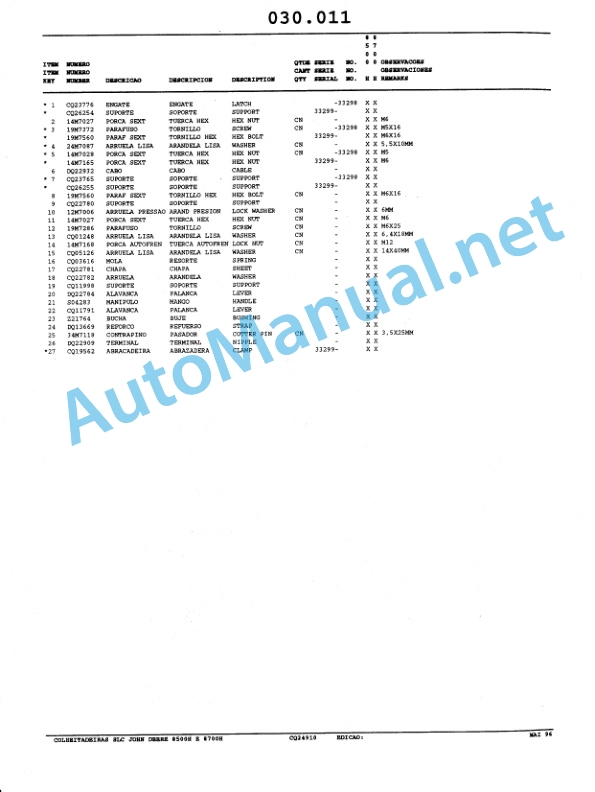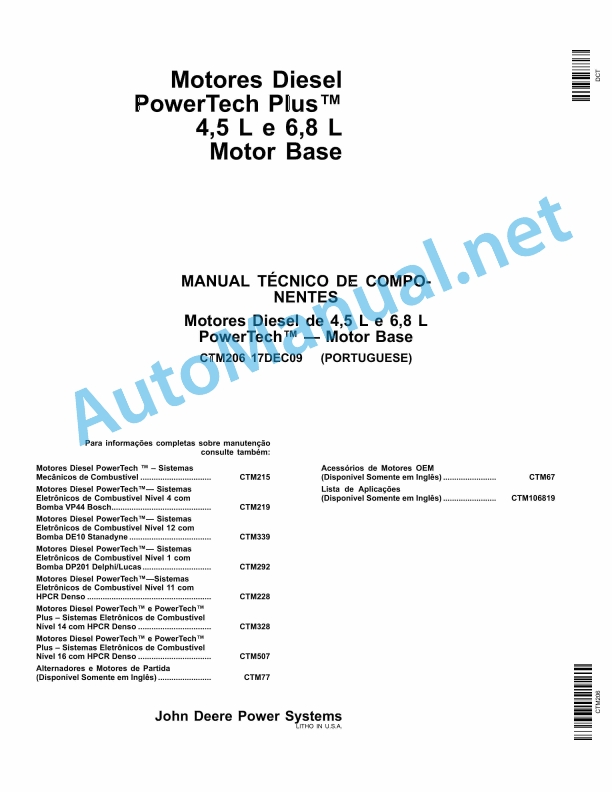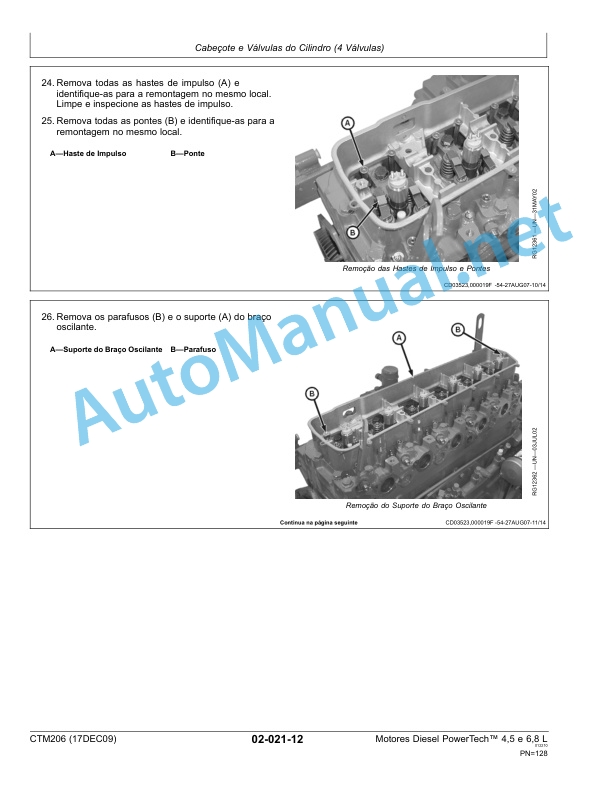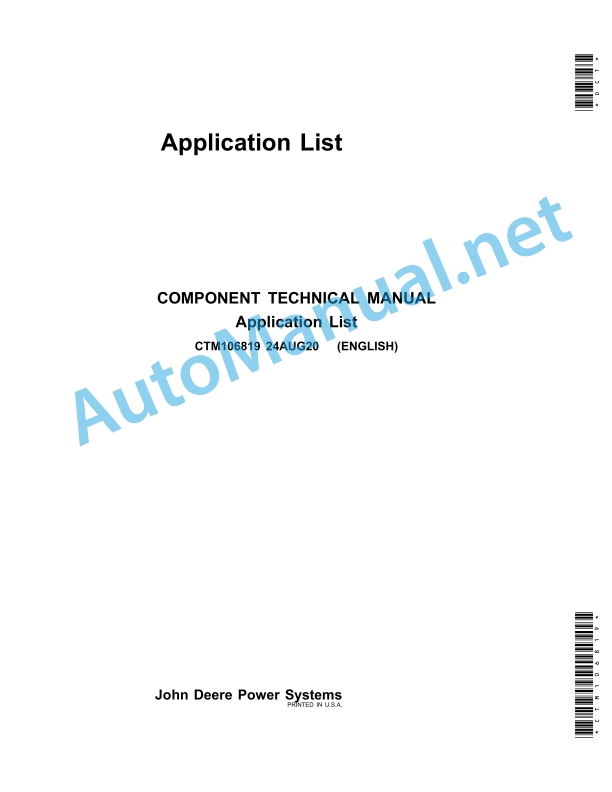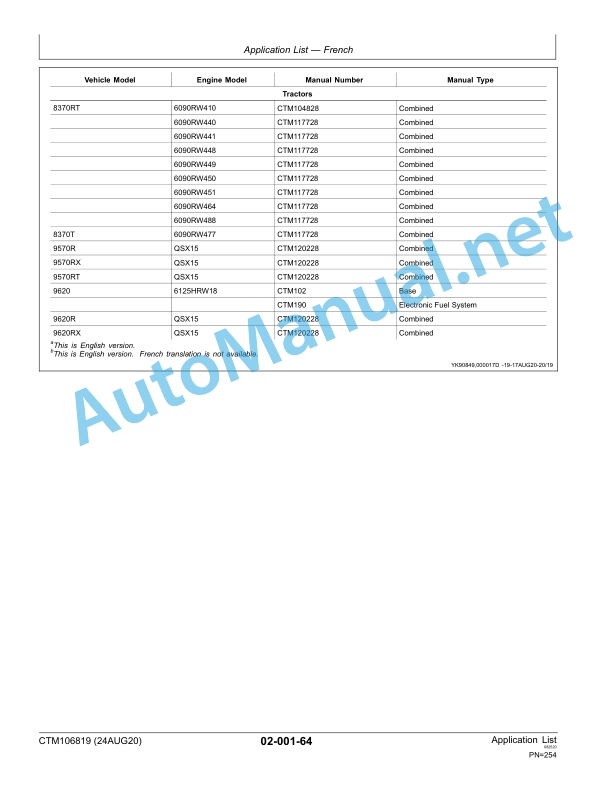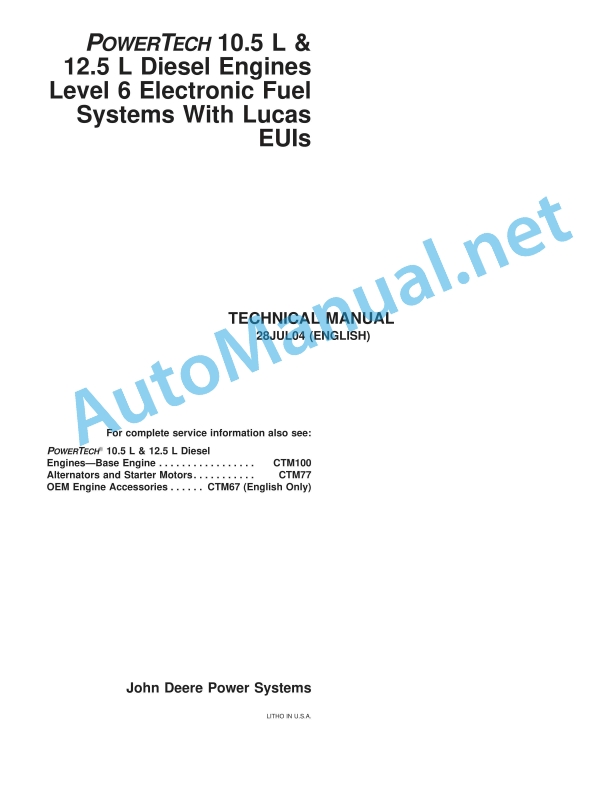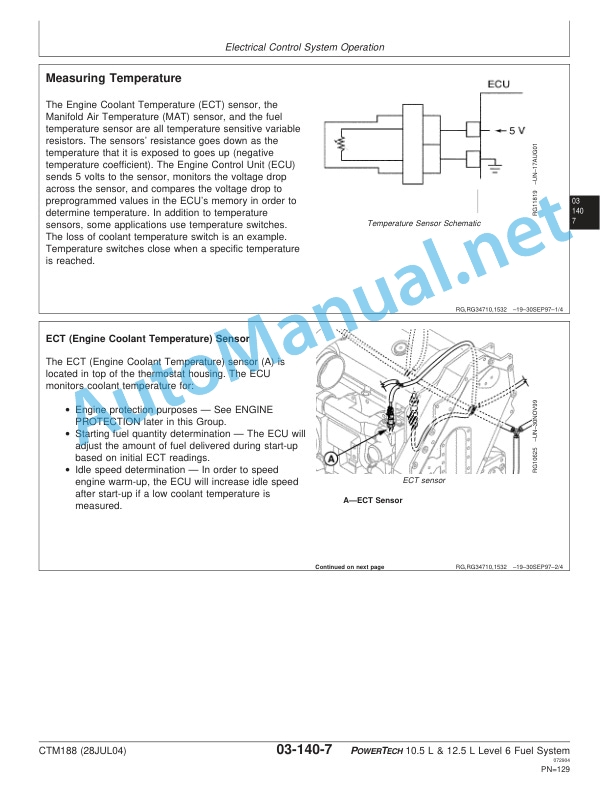Claas Rb 140 130 Tier2 (A16) Tractors Operator Manual ES
$50.00
- Model: Rb 140 130 Tier2 (A16) Tractors
- Type Of Manual: Operator Manual
- Language: ES
- Format: PDF(s)
- Size: 8.4 MB
File List:
00 1116 909 0.pdf
00 1116 909 0.pdf:
For your security
Signal triangle
Use according to the purpose
Chapter symbols
NE_BASSO_1007_TDM05A.pdf
SOMMAIRE
A – IDENTIFICATION – APPROVAL – SECURITY
IDENTIFICATION A. 2
SAFETY A. 3
Safety stickers with warning pictograms A. 13
Controls and cockpit B. 2
Indicators and control lights B. 3
ALARMS B. 4
Digital display (option) B. 5
Controls and accessories B. 7
DRIVER SEAT B. 8
Folding bow B. 9
C – ELECTRICITY
CHARACTERISTICS C. 2
LIGHTING SIGNALING C. 4
CONTROLS C. 5
Fuses C. 7
D – ENGINE
CHARACTERISTICS D. 2
Operations to be carried out before start-up D. 3
USE D. 5
Bleeding the air from the injection circuit D. 8
E – Transmission
Speed calculation table E. 2
Table of forward speeds E. 3
Forward clutch E. 4
GEARBOX E. 5
Selection of ranges E. 7
differential E. 7
Braking E. 8
E Permanent job E. 12
Tractor trailer E. 12
F – FRONT AXLE
FEATURES F. 2
Front axle gear F. 3
G – Hydraulic system – rear lift and hitch
CHARACTERISTICS G. 2
Rear lift G. 3
REAR HITCH ADJUSTMENT INSTRUCTIONS G. 5
AUXILIARY DISTRIBUTORS G. 8
J – WHEELS AND TIRES
GENERALITIES J. 2
INFLATION PRESSURE J. 2
Tires and tracks J. 4
COMMISSIONING J. 7
SWIVEL STOPERS J. 8
K – Dimensions, weights, capacities and ballast
Arch version dimensions K. 2
Weight K. 3
Ballast K. 3
K.5 Capacities
L – MAINTENANCE
GENERALITIES L. 2
M – Mandatory guarantee operations
MANDATORY OPERATIONS CARRIED OUT WITHIN THE FRAMEWORK OF THE CONTRACTUAL WARRANTY M. 2
CHAP-A-05A.pdf
A – IDENTIFICATION – APPROVAL – SECURITY
A – Type of tractor.
B – Approval number.
C – Tractor identification number.
D – Total allowable weight depending on the tires (in kg).
E – Weight on the front axle.
F – Weight on the rear axle.
G – Allowable towable weight without brake (in kg).
H – Allowable towable weight with mechanical brake (in kg).
I – Allowable towable weight with inertia brake (in kg).
J – Allowable towable weight with assisted brakes (in kg).
K – Smoke absorption coefficient.
Homologation
SECURITY
PRECAUTIONS TO BE TAKEN BEFORE CARRYING OUT START-UP
TRACTOR CONDITION
ADJUSTMENT OR MAINTENANCE WORK – REPAIRS
PLACING ON SUPPORTS
Hydraulic
ELECTRICITY
CIRCULATION – TRANSPORTATION
UTILIZATION
GENERAL RULE
TRACTOR WHEEL BASE
TOOL HOOKING
JOBS IN FIXED POSITION
WORK WITH TOOLS POWERED BY THE POWER TAKE-OFF
TOXIC PRODUCTS
Refrigeration
RECOMMENDATIONS:
SECURITY STRUCTURE
REGARDING THE ENVIRONMENT
Safety stickers with warning pictograms
CHAP-B-05A.pdf
Controls and cockpit
1 – PTO clutch lever.
2 – Control of driving lights, turn signals and acoustic warning.
3 – Clutch pedal.
4 – Steering wheel height adjustment lever.
5 – Dashboard.
6 – Hand throttle lever.
7 – Gear reverse lever.
8 – Brake pedals.
9 – Accelerator pedal.
10 – Gear lever.
11 – Range lever.
12 – Position control lever.
13 – Effort control lever.
14 – Auxiliary distributor levers.
15 – PTO selector.
16 – Front axle interlock contactor.
17 – Hazard lights contactor.
18 – Work lights ignition contactor.
Indicators and control lights
1 – Revolution counter.
2 – Engine cylinder head temperature indicator.
3 – Fuel level indicator.
4 – Fuel reserve warning light.
5 – Preheating indicator.
6 – Battery charge indicator.
7 – Dry air filter clogging indicator.
8 – Engine oil pressure warning light.
9 – Front axle interlock warning light.
10 – Tractor turn signal light.
11 – Handbrake warning light.
12 – PTO operation warning light.
13 – Reservation site.
14 – Position lights indicator.
15 – 1st trailer turn signal light.
16 – High beam warning light.
17 – Digital display (option).
18 – Hourmeter.
19 – Hydraulic duplicator placement indicator.
RED LIGHTS PRIMARY ALARMS
Battery charge indicator
Engine oil pressure warning light
Handbrake warning light
ORANGE SECONDARY ALARMS WARNING LIGHTS
Dry air filter clogging indicator
When this light comes on, it is advisable to change the main filter element.
Fuel reserve warning light
Digital display (option)
Digital display parameters
Screen parameterization procedure
1 – With the ignition off, press the programmed button (2) and turn on the ignition.
2 – Release the button (2). The display indicates SET.
3 – Press button (2) again until the new desired parameter appears on the screen.
4 – Release the button. The display indicates OFF.
5 – Return the ignition key to position 0.
Parameter table
Controls and accessories
Adjustable steering column
Adjustment
DRIVER SEAT
waterproof seat
1 – Longitudinal adjustment.
2 – Suspension adjustment.
3 – Adjustment according to weight.
folding bow
CHAP-C-05A.pdf
C – ELECTRICITY
CHARACTERISTICS
Battery: 12 V – 100 Ah
Alternator: 14 V – 55 A
POWER SUPPLIERS
Trailer/tool lighting socket (A)
1 – Turn signals on the left side.
2 – Available.
3 – Mass.
4 – Turn signals on the right side.
5 – Right position lights + License plate illuminator.
6 – Stop.
7 – Left position lights.
Power socket electrical box (B)
Lighting – signaling
IN THE FRONT
1 – Dippegh beights.
2 – Side indicators:
IN THE BACK
3 – Work lights.
4 – Plate illuminator
5 – Side indicators:
6 – Trailer/tool lighting socket.
7 – Catalights.
CONTROLS
Flashing
Sound warning (III)
Driving lights
Bursts of lights
Gyro beacon control
distress signal
work light
key contactor
Key switch position
Fuse box (2) : Mechanical duplicator version only
Hydraulic bender version only
CHAP-D-05A.pdf
D – ENGINE
CHARACTERISTICS
Operations to be carried out before starting
Engine start and stop
ENGINE STARTING
Startup under normal conditions
In cold weather
ENGINE STOP
UTILIZATION
Generalities
Recommendations:
1 – Avoid working under load or long idling operations. A lack of charging in the first 100 hours can cause the liners taze. The equence is excessively high oil consumption and a lack of power.
2 – Avoid overload work: there is overload when using a gearbox ratio that is too high and with…
3 – In particular, monitor the levels (oil and coolant) as well as the engine temperature.
Operating temperature
REGIME OF USE
Slow motion
Maximum vacuum regime
Nominal regime
The nominal engine speed is reached at maximum power.
Maximum speed on the road
Specific consumption
Work with partial potential
Work at full power
Generalities
Quality requirement
Tank filling
1 – Clean the area around the diesel canister cap.
2 – Dismantle the cap and put it in a clean and dry place.
3 – After filling, replace the cap and tighten it.
Fuel handling
Bleeding air from the injection circuit
CHAP-E-05A.pdf
E – Transmission
Speed calculation table
Engine speed 2 200 rpm
Reduced ranField range. Road range.
Forward speed tables
forward clutch
mechanical gear reverser
I March forward.
II Reverse gear.
Mechanical range bender
The maneuver of this lever can be carried out when the tractor is moving. To do this, release the accelerator pedal, disengage the clutch, move the lever to the chosen position, gradually engage the clutch and accelerate.
Electrohydraulic range bender
Range selection
Differential
Brake pedal (1)
Hand brake
To tighten:
To untighten:
trailer brake
Hydraulic braking
power take off
Rear power take-off with mechanical clutch
Disengagement
Selection of power take-off regimes
PTO tool hitch and trailer
Important
Permanent job
tractor trailer
CHAP-F-05A.pdf
F – FRONT AXLE
Characteristics
Front axle gear
Utilization
CHAP-G-05A.pdf
G – Hydraulic system – rear lift and hitch
Characteristics
Hydraulic pump
Oil capacities
Trailer brake hydraulic valve (depending on equipment)
Hydraulic lifting
rear lift
Position control
Utilization
Effort control
Utilization
Adjustment
Tool maneuver at the end of the field
Swing hitch
Rear hitch adjustment instructions
Influence of hitch geometry on lifting capacity
A – Upper bar (attachment point of the upper connecting rod with respect to the wheel axis and length of the connecting rod). High position: 221 mm. Middle position: 281 mm. Low position: 346 mm.
B – Lower bars (attachment point of the lifting rods on the lower bars).
C – Lifting rods (length of the lifting rods).
Maximum mechanical advantage
Minimum mechanical advantage
Lifting Rod Adjustment
Stiffening adjustment
Adjusting the lateral stabilizers
Hydraulic adjustment of lateral stabilizers
Auxiliary distributors
Control levers and pressure taps
Maneuver
Hydraulic couplers
PRESSURE OUTLETS IN THE REAR
PRESSURE OUTLETS Side part
Single acting distributor
Utilization
Putting under pressure
Double-acting 3-position distributor
Utilization
Double-acting 4-position distributor
Double acting/single acting conversion
Flow regulator
UTILIZATION
Free return
Brake valve
Rear hitches
hitch fork
CHAP-J-05A.pdf
J – WHEELS AND TIRES
GENERALITIES
REPLACING TIRES, INSTALLING TRAINS OF DIFFERENT TIRES
Particular case of four-wheel drive tractors
Synchronism ratio
INFLATION PRESSURE
Tire marking
Work on soft ground (search for better grip)
Work on hard ground (on the road, trailer, etc.)
rear axle
Tires and tracks
The front track is the distance on the ground that separates the center of the front tires. The rear track is the distance on the ground that separates the center of the rear tires.
Tire combinations Available in 4 RM
Front track charts (4 wheel drive tractor)
Rear track boards
COMMISSIONING
Front and rear axle
Way laying method
SWIVEL STOPERS
Adjustment
CHAP-K-05A.pdf
K – Dimensions, weights, capacities and ballast
Arch version dimensions
(with stock tires)
Ballasted
At the chain exit, the tractors are ballasted in order to behave normally in most cases of use. However, depending on the working conditions, the ballast can be modified (see ballast table).
Ballasted with water
On tractors with 4-wheel drive, 50% water ballasting is authorized on the front tires.
Tire filling
Capabilities
The following table indicates the quantities of lubricant and fluid to be used for each organ.
Only use recommended lubricants and fluids.
When refilling, it is mandatory not to change the oil or fluid category.
Regular oil changes are essential.
CHAP-L-05A.pdf
L – Maintenance
Generalities
Warnings
General cleaning
High pressure cleaning system
Current interventions
Paint touch ups
FAULTS OR MALFUNCTIONS
Downgrade
Amount and type of oil
Fat quality
Diesel prefilter: Cleaning – Change
Engine air filter: Cleaning
Forward clutch guard: Control
Splice the support *1 on the power take-off clutch control *2: Control
Strap: Control – Change
Hydraulic / transmission oil level (Gearbox + Rear axle): Check
Engine oil level: Check
Calender grilles: Cleaning
Turbine, radiator, cylinder fins and cylinders: Cleaning
Positioning the front axle arm: Greasing
Transmission shaft: Grease
Front axle steering pivots: Greasing
Rear Lift: Greasing
Front axle final reduction oil level: Check
Tighten disc and wheel rim nuts: Control
Tire inflation pressure: Check
Front axle differential case oil level: Check
Brake pedals – Brake valve level (for trailers: Control
Transmission hydraulic circuit filter cartridge: Change
Tightening of the front masses: Check
Engine oil: Change
Battery electrolyte level: Cleaning – Greasing
Engine oil filter cartridge: Change
Hydraulic shower head: Change
Diesel filter cartridge: Change
Handbrake Guard: Control
Wheel trumpets: Greasing
Front axle differential case oil: Change
Front axle final reduction oil: Change
Front axle breather: Change
Hydraulic oil – transmission: Gear
Rear exhaust valve: Change
Starter and alternator
Engine air filter (dry cartridge): Change
Manifold tightening: Control
Rocker arms and injectors: Control
Injectors
Diesel prefilter
ONBOARD NOTEBOOK OF MAINTENANCE OPERATIONS
Operations to be carried out every 250 hours
Operations to be carried out every 500 hours
Operations to be carried out every 1,000 hours
Operations to be carried out every 2,000 hours
CHAP-M-05A.pdf
M – Mandatory guarantee operations
MANDATORY OPERATIONS CARRIED OUT WITHIN THE FRAMEWORK OF THE CONTRACTUAL WARRANTY
Inspection before delivery – Delivery to customer
a) Inspection before delivery
Your supplier, holder of the CLAAS label, is responsible for preparing your tractor before delivery:
You must put your seal and signature after having checked and validated the maintenance card controls.
At your request, you can also install approved equipment or any After-Sales option (cooling, power take-off and front lift, radio, etc.).
b) Delivery to the customer
When delivering the tractor, your supplier must also give you the use and maintenance guide. You should comment on this document and…
The Acknowledgment of receipt, Inspection before delivery and Delivery to customer forms (present in the maintenance card) must be completed and signed by the technician in charge of carrying out the practices, as well as by the user.
One of the copies of the acknowledgment of receipt will remain in the maintenance card given to the user. The other copies are destined for CLAAS.
MAINTENANCE OPERATIONS TO BE CARRIED OUT
HYDRAULIC CIRCUIT
HYDROSTATIC STEERING
FRONT UNIT – FRONT BRIDGE
TRANSMISSION – LIFT
WHEELS AND TIRES
ELECTRICAL CIRCUIT
Battery:
Dashboard:
Lighting:
HYDRAULIC CIRCUIT
HYDROSTATIC STEERING
FRONT UNIT – FRONT BRIDGE
TRANSMISSION – LIFT
WHEELS AND TIRES
ELECTRICAL CIRCUIT
Battery:
Dashboard:
Lighting:
John Deere Repair Technical Manual PDF
John Deere Parts Catalog PDF
John Deere Tractors 6300, 6500, and 6600 Parts Catalog CQ26564 (29SET05) Portuguese
John Deere Repair Technical Manual PDF
John Deere Repair Technical Manual PDF
John Deere Transmission Control Unit Component Technical Manual CTM157 15JUL05
John Deere Repair Technical Manual PDF
John Deere DF Series 150 and 250 Transmissions (ANALOG) Component Technical Manual CTM147 05JUN98
John Deere Repair Technical Manual PDF
John Deere Parts Catalog PDF
John Deere Harvesters 8500 and 8700 Parts Catalog CPCQ24910 Spanish
John Deere Repair Technical Manual PDF
John Deere Repair Technical Manual PDF
John Deere Application List Component Technical Manual CTM106819 24AUG20
John Deere Repair Technical Manual PDF

